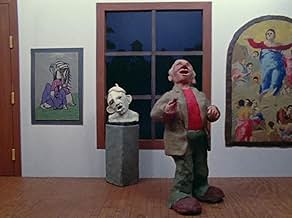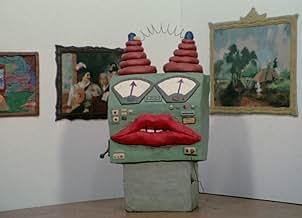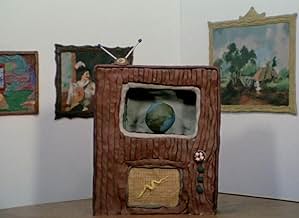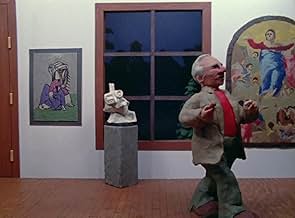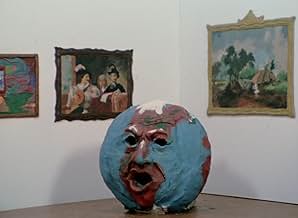Agrega una trama en tu idiomaA man visiting a museum sees the works of art come to life.A man visiting a museum sees the works of art come to life.A man visiting a museum sees the works of art come to life.
- Dirección
- Guionistas
- Elenco
- Ganó 1 premio Óscar
- 2 premios ganados en total
- Dirección
- Guionistas
- Todo el elenco y el equipo
- Producción, taquilla y más en IMDbPro
Opiniones destacadas
The 1974 winner of Best Animated Short depicts a man looking at artwork that appears to come to life. I especially liked the malfunctioning computer. One might interpret Will Vinton's "Closed Mondays" as a look at the relationship between humanity and the art that we produce. There's even the question of how to define art. I wouldn't call this my favorite Will Vinton cartoon, but I enjoyed it. Personally I don't think that enough people get to see the nominated animated shorts. They tend to be far more interesting than the features voiced by the celebrities of the moment.
Anyway, this one is worth seeing. It's too bad that Phil Knight took over Will Vinton's studio and fired Vinton from it.
Anyway, this one is worth seeing. It's too bad that Phil Knight took over Will Vinton's studio and fired Vinton from it.
A charming parable about thin border between life and art. A drinken man in an art gallery in evening. His discoveries , his experiences and the truths front to it.
A wise and seductive crafted short animation , a simple story about illusions and reality and one of perfect ends.
But the precious gift is the final feeling, a mix of nostalgia and tenderness , flavors of childhood and feeling of be older, both working in interesting manner together.
A parable, many. Useful for fair status of experience profound unique.
The result is a kick to reflection about significant things defining the life.
A wise and seductive crafted short animation , a simple story about illusions and reality and one of perfect ends.
But the precious gift is the final feeling, a mix of nostalgia and tenderness , flavors of childhood and feeling of be older, both working in interesting manner together.
A parable, many. Useful for fair status of experience profound unique.
The result is a kick to reflection about significant things defining the life.
A drunk finds an open door at an art gallery which is usually - for apparently very good reasons - CLOSED MONDAYS.
With this ingenious little cartoon, Will Vinton and his talented artists announced that they had entered the animation world in a big way. Their Claymation magic was able to ring the subtlest changes of emotion and bring out nuances of character remarkable for three dimensional props. As here, where the old inebriate finds himself drawn into the secret life of the various exhibits, so the viewers find themselves falling into a suspension of disbelief both rational & expectant.
Winner of the 1974 Oscar for Best Animated Short.
With this ingenious little cartoon, Will Vinton and his talented artists announced that they had entered the animation world in a big way. Their Claymation magic was able to ring the subtlest changes of emotion and bring out nuances of character remarkable for three dimensional props. As here, where the old inebriate finds himself drawn into the secret life of the various exhibits, so the viewers find themselves falling into a suspension of disbelief both rational & expectant.
Winner of the 1974 Oscar for Best Animated Short.
I've always preferred traditional animation to stop-motion/claymation. Whether it's Wilfred Jackson's 'The Old Mill (1937)' or Chuck Jones' 'What's Opera, Doc?,' classic animation indefinitely retains its timelessness and the ability to transport the viewer into a visual dimension entirely different from our own. When done correctly, claymation can, of course, be equally effective, but I didn't find this to be the case in 'Closed Mondays (1974),' an Oscar-winning short directed by Bob Gardiner and Will Vinton. When I looked at the old man in the art gallery, I wasn't transported into the film's world, but, rather, I recognised the character as a mass of shifting clay several inches in height and grimaced wryly as he shuffled across the floor in a completely awkward and unrealistic gait. The film contains some interesting ideas, but the animation is accomplished so clumsily that I was barred from entering its world; if films like 'A Grand Day Out with Wallace and Gromit (1989)' and 'Harvie Krumpet (2004)' were able to avoid these complications, then I'm less willing to cut this one some slack.
Nevertheless, I was certainly impressed with what 'Close Mondays' had to say about the nature of art. To consider each picture frame as a window into another world, filled with animate people and objects, is to add a new dimension to how one critically evaluates art. A masterpiece should possess the ability to make itself come to life before our eyes, and it is up to the viewer to contemplate the meaning of what we are seeing, and the events that might have led towards the image depicted in a painting. The frame of the lonely maid, forever condemned to solemnly scrub the cold stone floor, is almost heartbreaking in its poignancy; if only the remainder of the artworks were just as meaningful {I'm still trying to decide what that metamorphic super-computer was all about}. And, of course, I enjoyed the ending, confirming that behind every piece of art there is considerably more than initially meets the eye, an entire story just waiting to be told even if nobody is watching.
Nevertheless, I was certainly impressed with what 'Close Mondays' had to say about the nature of art. To consider each picture frame as a window into another world, filled with animate people and objects, is to add a new dimension to how one critically evaluates art. A masterpiece should possess the ability to make itself come to life before our eyes, and it is up to the viewer to contemplate the meaning of what we are seeing, and the events that might have led towards the image depicted in a painting. The frame of the lonely maid, forever condemned to solemnly scrub the cold stone floor, is almost heartbreaking in its poignancy; if only the remainder of the artworks were just as meaningful {I'm still trying to decide what that metamorphic super-computer was all about}. And, of course, I enjoyed the ending, confirming that behind every piece of art there is considerably more than initially meets the eye, an entire story just waiting to be told even if nobody is watching.
I saw this film on video when I was about seven years old. It was on a tape of various animated shorts, including "Sundae in New York". This was the last film to play, and I have to say I was astounded. Even as a child, I admired the haunting beauty of the animation, and the simple but surreal plot line. I already was a fan of Wil Vinton's work in "Return to Oz", but this film showed a unique creativity that still affects me to this day. I think that it is a crime that it is not available on DVD, and should be offered alongside some of Jan Svankmajer's work. The end (which I will not reveal) still makes me wonder about the nature of the man in the museum.
¿Sabías que…?
- TriviaThis short was included in the theatrical release of the compilation feature "Fantastic Animation Festival" (1977).
- Versiones alternativasThe version included in the video "Academy Award Winners - Animated Short Films" (released by Vestron Video) leaves out the words "Usual Crap" from the sign shown in the beginning of the film.
- ConexionesEdited into Fantastic Animation Festival (1977)
Selecciones populares
Inicia sesión para calificar y agrega a la lista de videos para obtener recomendaciones personalizadas
Detalles
Contribuir a esta página
Sugiere una edición o agrega el contenido que falta

